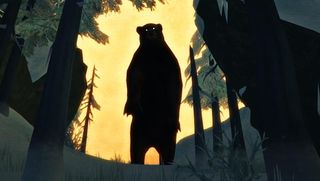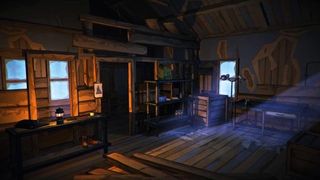Hinterland aimsto reinvigorate the survival genre with The Long Dark

Fiery watercolour skies and shimmering auroras are how Hinterland chooses to showcase its take on the end of the world, but even the most atmospheric screenshots can’t convey the sound of Canada’s deep north – the thunderous wind that scorns clothing and shakes window panes, or the thoughtful silence that follows fresh snowfall. Abstracting heavily, this Vancouver Island-based team of 13 is creating an escapist’s game, and it’s one that achieves an even better sense of place than DayZ’s hyper-real countryside of Chernarus.
Currently in Early Access, The Long Dark has you take on the troubles of a plane crash survivor in the wake of an as-yet-unspecified ‘geomagnetic event’. Alone in the mountains, you forage, craft and do what you must to survive, which mostly means keeping warm. There are no monsters in this wasteland, nor psychotic fellow players; The Long Dark is a staunchly singleplayer game. Occasional wolves might do for you, but the pervasive, unrelenting threat is the cold, which can kill you in minutes – sunny days in northern Canada can still be well below zero.
“It was all about coming up with a different take on that post-disaster scenario,” creative director Raphael Van Lierop says. “I’m very careful not to call it postapocalyptic, because for me postapocalyptic always has the wrong connotations. We’ve been taught that postapocalyptic means Mad Max, or Fallout or zombies – that’s not what we are.”
The Long Dark’s rampant colour certainly seems the obvious counterpoint to the drab eastern European settings common to this genre. The impressionistic style begs to be screengrabbed, the display of natural majesty enforcing an awareness of your precarious hold on the world. Inspired by the work of children’s writer and illustrator Jon Klassen, The Long Dark’s world was less saturated early in development, but the team soon realised it would need its screenshots to stand out.

“It started out as a practical thing,” says Van Lierop. “When you’re a small independent studio, you don’t have the resources of a big publisher to help market and promote your game. You need to have what marketing people would call an ‘ownable look’, and I say that with a little bit of cynicism, but it’s true. Without sounding too highfalutin about it, the intention behind The Long Dark is really to create an artistic experience that is emotional and hopefully thought-provoking.”
Mechanically, The Long Dark is in less of a hurry to break with tradition. For example, playing in either of its two extant sandboxes means rummaging through cupboards for canned peaches to keep food and thirst meters topped up. Hinterland has tried to strip back the typical information-heavy UIs that accompany this type of game, offering visual cues as to your wellbeing – the colder it gets, the more your breath fogs – but meters and lists remain in force. The team concedes that it can’t find a way to ditch the UI entirely without mystifying the game’s deaths, but pledges a more visual, intuitive adaptation of the menus for future updates.
The absence of player animations is also a point of contention at Hinterland. The timer bars that represent every action are the only barrier to full submersion in its survivalist fantasy, a disconnect that almost caused the combat system, in which you might struggle invisibly with a wolf, to be pulled. “I’m not saying we’ll never get there,” Van Lierop says, “but at any point when we’ve asked, ‘Is now the right time to tackle that?’ we’ve always had other things that felt more important.”
Sign up to the 12DOVE Newsletter
Weekly digests, tales from the communities you love, and more
Regardless, Hinterland’s interpretation of the survival formula is robust, thanks again to the severity of the environment. Just as any good horror has its audience unconsciously holding their breath, the descent of a blizzard can induce a psychosomatic chill in players as visibility drops and you stagger into the wind.

Effective though the cycle of foraging, upgrade and survival is in the short term, this genre has an endgame problem: one lucky raid or efficient day can see you stockpile supplies, granting immunity to nature’s attempts on your life as you gather still more essentials. Once you become self-sufficient, the game has been beaten without climax, leaving players to drift away unfulfilled. Accordingly, Hinterland began receiving complaints that The Long Dark was too survivable soon after implementing the Coastal Highway map.
“We knew we were going to create clusters of buildings,” Van Lierop says, “but we hadn’t quite anticipated how it would make the game feel easy for people. We tend to think about survival in the game as a longer term experience, so it’s easy for someone to go into the Coastal Highway and get to a cluster of five or six houses and survive for five or six days with the resources that are there, but that doesn’t mean that you’re going to survive for a hundred days.”
In light of the feedback, the team created a new sandbox that brings the playable area up from ten to 19 square kilometres. In contrast to the comparatively built-up Coastal Highway and the scattered houses of Mystery Lake, the new Pleasant Valley is a resolutely rural mountain region comprised of farmland and unspoiled wilderness.
Hinterland goes further in addressing the endgame problem, too. The team’s longterm goal isn’t just a polished sandbox in which to exist, but an episodic story in which survival is but a mechanic. “We’re fundamentally storytellers,” Van Lierop says. “The Long Dark wasn’t conceived as a survival game – we built The Long Dark from first principles. We said, ‘This is how we want to make the player feel. What are the mechanics, what is the aesthetic we need to deliver on that?’ Our full launch will be for the story mode. Story mode is the launch! Nobody wants to play a story mode before it’s finished, and we knew that the sandbox could be tested on its own, independently of narrative.”

Designing survival as a means to an end rather than the end itself is a lifeline for a genre in which many games stagnate in Early Access. After all, popular disaster series such as The Walking Dead are about human drama, not daily routine, and Van Lierop predicts that encounters with NPC survivors in the course of the story will be far more unsettling than the wolves that prowl the wastes.
After its recent boom, the survival genre is already looking short of ideas, but The Long Dark has stumbled in with fresh supplies. Inspired by the view from Van Lierop’s window and treks along local logging trails, Hinterland has created an authentic slice of Canada complete with toques and red maple leaves. As a result, its surrealist’s palette and extreme weather enforce not a sense of high fantasy, but a real place at the end of days. And now, rather than wait to expire, we can explore what comes after.
Edge magazine was launched in 1993 with a mission to dig deep into the inner workings of the international videogame industry, quickly building a reputation for next-level analysis, features, interviews and reviews that holds fast nearly 30 years on.
Most Popular
